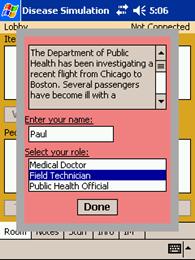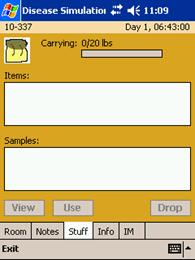Outbreak @ MIT (O@MIT)
| Home › Indoor O@MIT ('04)› M@M ('03)› Outdoor CRC ('04)› Ed ('03)› Contact › |
.
|
Outbreak @ MIT Like the other MIT AR games, Players in O@MIT are equipped with handheld Pocket PCs as their link between the real world and the virtual world of the game. The Pocket PCs are receiving location information based on simple Wi-Fi (wireless networking) positioning. Being in ubiquitous network coverage also allows the Pocket PCs in the game to stay connected to a server. Unlike the other games we have created to date, this allows all of the players in the game to live in one common world where the actions of one player have immediate (and delayed) effects on all of the other players. For example, a player might pick up a virtual item in a room, which would then not be accessible to any of the other players. Similarly, a player might contaminate a scene, move important items, or interact with an NPC in ways that have consequences for other players. This fundamental change in the game engine has opened up new opportunities of game play and learning exploration.
The game engine shares some common features with previous games, like the ability to take interviews and samples, but also adds virtual limited objects that have specific purposes. Perhaps most importantly, it adds a hidden layer through which the server can determine how the disease is spreading amongst the real and virtual players within the game. Using some simple disease modeling, the spread of the disease can be modeled based on the actions and whereabouts of the players involved in the game. This means that they must do their best to prevent the spread of the disease and assess their own progress and status.
To see an overview of the game take a look at the Technical Overview Presentation (in Flash).
|
|
|
 Take and analyze samples from real and virtual players in the game to test for the presence of diseases.
Take and analyze samples from real and virtual players in the game to test for the presence of diseases. In initial runs of the game with both educators and public health experts, the dynamics and principles of the game have proven to be intriguing and promising. Further refinements and changes on this platform will come over the next six to nine months. Like the outdoor games, we intend to distribute an editor and game engine for this platform.
In initial runs of the game with both educators and public health experts, the dynamics and principles of the game have proven to be intriguing and promising. Further refinements and changes on this platform will come over the next six to nine months. Like the outdoor games, we intend to distribute an editor and game engine for this platform.